Williamson on Dolan, Tissier on “Neo” Bishops, Fellay on Both
by Rev. Anthony Cekada
OVER THE past few weeks, the topic of episcopal consecrations has come up several times. Bergoglio (“Pope Francis”) consecrated two bishops using the post-Vatican II rite; Bishop Daniel L. Dolan celebrates the twentieth anniversary of his episcopal consecration in the traditional rite on November 30; and in response to a number of inquiries, one of my earlier posts this month put together links to the several articles I’d written on the post-Vatican II Rite of Episcopal Consecration that Paul VI promulgated in 1968.
Many readers are not aware of the opinions the bishops of the Society of St. Pius X have held on these issues, so I thought I would provide some information here.
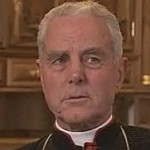 1. Bp. Williamson on Bp. Dolan’s Consecration
1. Bp. Williamson on Bp. Dolan’s Consecration
On November 30, 1993, Bishop Mark A. Pivarunas consecrated to the episcopacy Father Daniel L. Dolan a a priest ordained by SSPX founder Abp. Marcel Lefebvre. Bp. Pivarunas’s own episcopal orders derived from Abp. Pierre-Martin Ngo-dinh-Thuc, former archbishop of Hué, Vietnam. Since Bp. Dolan had started out in SSPX, there was a considerable amount of interest as to how one was to regard his consecration. Bp. Dolan was a sedevacantist and one of “the Nine” whom Abp. Lefebvre had expelled from the Society in April 1983, so he was not exactly on the organization’s most favored list. But apart from that, would he be a validly consecrated bishop or not?
A layman wrote to the Rector of the SSPX seminary in Winona MN, Bishop Richard N. Williamson to inquire, and sent him my 1992 study, The Validity of the Thuc Consecrations. On October 21,1993, about five weeks before the consecration, Bp. Williamson replied as follows:
Thank you for this letter, as [well as] for the booklet by Fr. Cekada on the Thuc Consecrations, which I had seen.
I think that Fr. Cekada’s arguments are good, such that I agree with him and not with Fr. Kelly or Fr. Jenkins as to the VALIDITY of the up-coming consecration.
However, one must distinguish validity from liceity or lawfulness. A consecration can be valid, but unlawful, like eating a stolen apple. The eating is valid; it satisfies my hunger, but if the apple was stolen, then the eating is unlawful.
Is the up-coming consecration lawful? Answer: if (a) the Cincinnati operation of these priests is lawful, and if (b) they need a bishop imperatively, then the consecration would be lawful.
But as to (a), these Cincinnati priests are not ordinary traditional priests; they were Society of St. Pius X priests who broke with Society of St. Pius X positions to take up harsh and un-Catholic positions, out of line at any rate with Archbishop Lefebvre’s thinking. Yet the future bishop on the flyer advertising his consecration leads one to think that there was no such split with the Archbishop. Conclusion: the Cincinnati priests’ operation is doubtfully lawful.
As to (b), if their operation is doubtfully lawful, then a consecration is at best doubtfully necessary.
Conclusion: however much it would interest you to attend a consecration, you would best stay away from a doubtfully Catholic occasion.
I hope this answers your question.
Sincerely yours in Christ,
+ Richard Williamson
While one of the principles is vintage Williamson for that era and one which His Excellency has since abandoned (outside SSPX one is “doubtfully Catholic”), the main point is clear enough: One should regard Bp. Dolan’s consecration as valid.
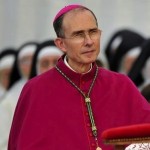 2. Bp. Tissier on Bishops Ordained in the New Rite
2. Bp. Tissier on Bishops Ordained in the New Rite
As I pointed out at the beginning of Absolutely Null and Utterly Void, Abp. Lefebvre personally told me in the mid-70s that he regarded the 1968 Rite of Episcopal Consecration as invalid because of a change in its essential sacramental form (=the one necessary phrase in a rite that makes it “work”).
By 1982, however, once Lefebvre undertaken another of his periodic bouts of negotiation with the Vatican, he changed his position, apparently under the impression that Paul VI form was used in the Eastern Rites, and therefore unquestionably valid. (The basis for his impression, it seems, was a “study” by Fr. Franz Schmidberger, who favored reconciling with John Paul II. According to a seminarian who later asked to read the study, it turned out to be nothing more than a single page in a folder!)
Surprisingly, it seems that no one in the traditionalist movement had attempted to analyze the new rite in any great detail until Rama Coomaraswamy published his own study in the early 1990s. This focused on the phrase spiritus principalis in the essential form. What did it mean? Was it sufficient to signify the order of bishop, and thus effect the sacrament? Dr. Coomaraswamy concluded that it was not.
Even though Abp. Lefebvre had changed his position to favor validity and even though a bishop ordained in the new rite, Mgr. Salvador Lazo Lazo, had worked with the Society and confirmed under its auspices, some in the organization were now willing to consider the possibility that the new rite was doubtful or invalid — i.e. that it did not therefore make real bishops.
Someone passed Dr. Coomaraswamy’s study along to Bp. Bernard Tissier de Mallerais, who was then residing at SSPX headquarters in Menzingen Switzerland. In a August 12, 1998 letter, the bishop replied:
Thank you for sending me a copy of Dr. Rama Coomarawamy’s pamphlet “Le Drame Anglican.”
After reading it quickly, I concluded there was a doubt about the validity of episcopal consecration conferred according to the rite of Paul VI.
The [phrase] “spiritum principalem” in the form introduced by Paul VI is not sufficiently clear in itself and the accessory rites do not specify its meaning in a Catholic sense.
As regards Mgr Lazo, it would be difficult for us to explain these things to him; the only solution is not to ask him to confirm or ordain.
Yours very truly in Our Lord Jesus Christ,
+Bernard Tissier de Mallerais
PS: Another thought: Mgr Lazo has already confirmed “quite a few” [people] with us. Obviously, this is valid because “the Church supplies” (canon 209), because a simple priest can confirm with jurisdiction. And it is difficult to see how to make our doubt known to Mgr Lazo. So silence and discretion about this, please!
Bp. Tissier’s letter was finally published in December, 2000, several months after Mgr Lazo’s death.
Here, once again, the conclusion is clear: Bp. Tissier believed that the new Rite of Episcopal Consecration was doubtful – which means that in the practical order, one must treat it as invalid.
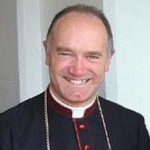 3. Bp. Fellay on Bp. Dolan and Bishops Ordained in the New Rite
3. Bp. Fellay on Bp. Dolan and Bishops Ordained in the New Rite
While both Bp. Williamson and Bp. Tissier based their judgements about the validity of the respective episcopal consecrations upon objective theological principles, the same, it appears, could not be said for Bp. Bernard Fellay, Superior General of SSPX since 1994. His main concern seems to have been political: What effect would SSPX’s position on either issue (Abp. Thuc’s episcopal consecrations or the new rite) have on the organization’s dealings with modernists in the Vatican?
SSPX’s negotiations with the Vatican for reintegration into the Conciliar Church had broken down in 1988, after Abp. Lefebvre was excommunicated for consecrating four bishops, including Fellay. During the course of an SSPX pilgrimage to Rome in 2000, Bp. Fellay managed to kickstart the negotiation process with the Vatican once again, and it was in with smoothing the way for a deal that the two “bishop-related” issues mentioned above would surface. This was especially so because Joseph Ratzinger, who had been elected by the March 2005 conclave and was very well disposed towards a deal with SSPX, had a personal stake in either issue.
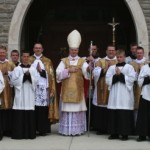 A. Orders Derived from Abp. Thuc. In 1983 Ratzinger, then a cardinal and head of the Congregation for the Doctrine of the Faith, issued a notification excommunicating Abp. Thuc and several bishops he had consecrated in 1981, including Bp. Moises Carmona Rivera, through whom Bp. Dolan derives his episcopal orders. The decree, while avoiding the question of validity (a concept which the modernists detest), said that the Vatican would not recognize those ordained as bishops, and consider them to be in whatever state they were before.
A. Orders Derived from Abp. Thuc. In 1983 Ratzinger, then a cardinal and head of the Congregation for the Doctrine of the Faith, issued a notification excommunicating Abp. Thuc and several bishops he had consecrated in 1981, including Bp. Moises Carmona Rivera, through whom Bp. Dolan derives his episcopal orders. The decree, while avoiding the question of validity (a concept which the modernists detest), said that the Vatican would not recognize those ordained as bishops, and consider them to be in whatever state they were before.
Since the document had been issued by the same Ratzinger with whom Fellay was negotiating in 2005, politics had to trump sacramental theology. Fellay therefore conditionally confirmed children who had earlier been confirmed by Bp. Dolan.
And in this, Fellay even out-Ratzingered Ratzinger, because, as we saw Bp. Tissier point out above, even a priest can validly confirm using supplied jurisdiction in certain circumstances — a principle we were all taught in the SSPX seminary at Ecône, and even heard several times from Abp. Lefebvre himself.
When deal-making was not endangered, the SSPX attitude was far more elastic. Fr. Bruno Schaeffer, a priest ordained by Abp. Thuc around the time of the 1981 consecrations, worked with SSPX for several years without ever being required to submit to conditional ordination. Until his recent death, he offered Mass regularly in SSPX’s principal church in Paris. He was also a sedevacantist, but here, too, yet another exception was made because, it is said, he inherited great private wealth.
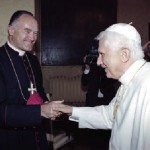 B. Ratzinger Consecrated in the New Rite. The second problem was even more delicate. Ratzinger himself had been consecrated a bishop in the new rite. If Ratzinger suspected that Fellay and a substantial number of SSPX clergy and hangers-on didn’t even think he was a bishop, how could he “reconcile” SSPX?
B. Ratzinger Consecrated in the New Rite. The second problem was even more delicate. Ratzinger himself had been consecrated a bishop in the new rite. If Ratzinger suspected that Fellay and a substantial number of SSPX clergy and hangers-on didn’t even think he was a bishop, how could he “reconcile” SSPX?
The issue surfaced nearly at once. In the summer of 2005, a few months after Ratzinger’s election, a French traditionalist publisher put out a book-length study of the new Rite of Episcopal Consecration that concluded it was invalid. Its cover carried side-by-side photos of Ratzinger and Fellay.
This got the attention of SSPX higher-ups, just as it surely got the attention of the Vatican. A traditionalist order in the SSPX orbit, the Dominicans of Avrillé, was given the task of pulling Bp. Fellay’s fat out of the fire by trying to make a case for the validity of the new rite. They published a lengthy article in Fall, 2005, which appeared shortly thereafter in the U.S.
The article was long, baffling, and left key terms undefined. It never managed to focus on two central questions: (1) What principles does Catholic sacramental theology employ to determine whether a sacramental form is valid, and (2) How do those principles apply to the new Rite of Episcopal Consecration? I waded into the controversy in March 2006 with my first article on the topic, supplemented subsequently with sets of responses to objections (see here) and even interviews on French radio (probably sounding to the French the same way Inspector Clouseau sounds to Americans…)
In any event, the Avrillé article gave Bp. Fellay enough cover to allow the negotiations to proceed for several years, until they were broken off in early 2013. With the election of Bergoglio in March, the prospect of a deal is now dead.
So in the twelve-year pursuit of the deal that never came, all Bp. Fellay accomplished was selling out principles of sacramental theology that his episcopal confreres in SSPX had no problem understanding. One can always hope that a future successor to Bp. Fellay will learn the lesson and have the sense to follow a different course.
+ + +
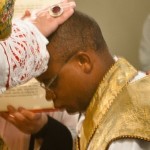 Help Send this Priest to Nigeria for Christmas Mass
Help Send this Priest to Nigeria for Christmas Mass
His fellow traditional Catholics await him.
Share the gifts you thank God for on Thanksgiving!
3 Trackbacks/Pingbacks
[…] The SSPX and the new rite of Episcopal Consecration Bishop Williamson's opinion on the Thuc line. Bishop Tissier's opinion on the New Rite for Episcopal Consecration. And Bishop Fellay's politicking with the Roman authorities. Fr. Cekada walks us through the issues. […]
[…] el nuevo rito” (ver “El obispo Tissier disputa Validez de Novus” Ordinary Ordinations “ y ” SSPX Bishops on Bishops and ‘Bishops’ “ ).[Vea en el blog, en español Mons. Tissier habla sobre la invalidez de las órdenes […]
[…] nuevo rito” (ver “El obispo Tissier disputa Validez de Novus” Ordinary Ordinations “ y ” SSPX Bishops on Bishops and ‘Bishops’ “ ).[Vea en el blog, en español Mons. Tissier habla sobre la invalidez de las órdenes […]